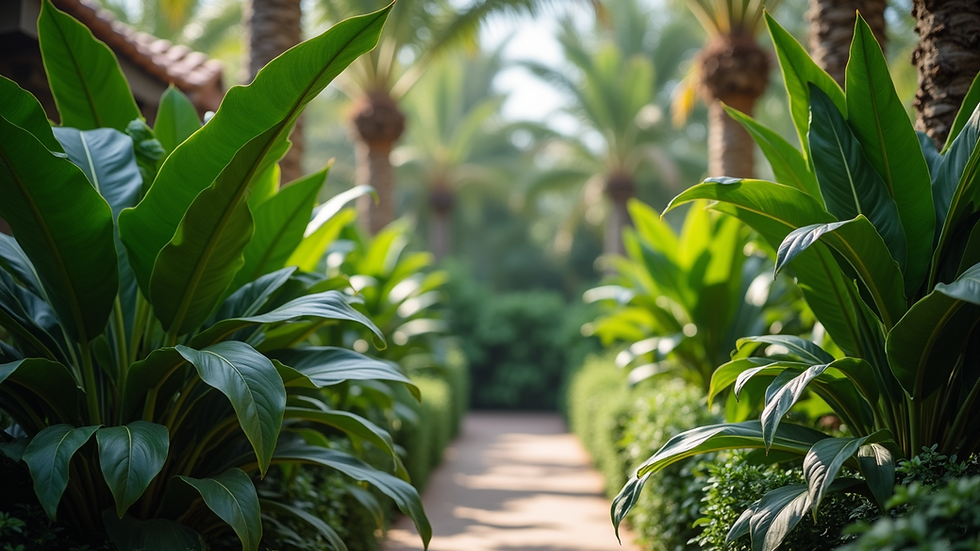Essential Tips for Growing Healthy Tropical Plants
- Brandon Hall

- Jun 15
- 3 min read
Tropical plants are a stunning addition to any home or garden, bringing vibrant colors and lush greenery. With the right care, these plants can thrive and enhance your living space. In this post, we will explore essential tips for growing healthy tropical plants, ensuring that you can enjoy their beauty for years to come.
Understanding Tropical Plant Care
Tropical plants originate from warm climates and thrive in conditions that mimic their natural habitat. They require specific parameters for light, humidity, temperature, and soil. Understanding these needs is the first step toward successful tropical plant care.
Light Requirements
Tropical plants generally prefer bright, indirect light. For instance, species like philodendrons and pothos thrive under such conditions. However, some plants, like succulents and cacti, prefer direct sunlight.
How to Determine Light Levels: Place your hand close to the plant. If you can cast a distinct shadow, the light is too bright. A good rule of thumb is to position plants near east or west-facing windows, where they can receive ample light without being burned.

Humidity and Temperature
Tropical plants flourish in humid environments. Most of these plants prefer humidity levels between 60% to 80%. Here's how to ensure your plants stay properly hydrated:
Misting: Regularly mist your plants with water to maintain humidity. This is especially important during winter months when indoor air tends to be dry.
Pebble Trays: Place trays of water filled with pebbles underneath your plants. The water will evaporate, increasing humidity around the plant.
Temperature-wise, tropical plants like it warm. The ideal range is between 65°F to 85°F (18°C to 29°C). Ensure they are not placed near drafty windows or heating vents, as sudden temperature changes can stress them.

Soil Type and Fertilization
Good quality soil is crucial for healthy tropical plants. They prefer a well-draining potting mix that mimics their natural habitat. Look for soil that includes components like:
Peat Moss: Helps with moisture retention.
Perlite or Sand: Enhances drainage.
When it comes to fertilization, using a balanced, water-soluble fertilizer every 4-6 weeks during the growing season can stimulate growth. The growing season typically runs from spring to fall.
Watering Practices
Overwatering is a common issue among tropical plant owners. Instead of sticking to a rigid schedule, observe your plants. Here are practical tips for effective watering:
Check the Soil: Always check the top inch of soil. If it feels dry, it is time to water. Ensure you allow the pot to drain well after watering to avoid root rot.
Signs of Overwatering: Yellowing leaves or a drooping plant are signs that you may be watering too much.
Pest Control
Just like any plant, tropical varieties are susceptible to pests. Common pests include spider mites, aphids, and mealybugs. Here are effective strategies for keeping your plants pest-free:
Regular Inspections: Check the leaves and undersides regularly for signs of pests. Early detection is key to avoiding infestations.
Natural Remedies: Use insecticidal soap or neem oil as a natural pest control method. These products are effective and safe for your plants.
Pruning and Repotting
Pruning and repotting are essential to maintain healthy tropical plants. Here’s how to do it correctly:
Pruning: Remove dead or yellowing leaves to redirect the plant's energy toward new growth. Use clean, sharp scissors to avoid damaging the plant.
Repotting: Every couple of years, or when you notice roots coming out of the drainage holes, it's time to repot. Choose a larger pot with fresh potting mix to help the plant continue to grow healthy.
Additional Considerations for Tropical Plant Care
Every plant species has unique needs. Research the specific requirements of your tropical plants, as there are many varieties with different preferences. For example, some may need more frequent watering, while others thrive on less.
It's also worth noting that tropical plants can be affected by seasonal changes. During winter, reduce watering and feeding as the plants enter a dormant phase.
Incorporating a mix of tropical plants can also benefit your indoor environment. Different plants can contribute to a balanced atmosphere and increase air quality.

Final Thoughts on Growing Tropical Plants
Growing tropical plants can be a rewarding experience. By understanding their specific needs and implementing the tips mentioned above, you can create a thriving environment for your green friends. Remember, consistent monitoring and adjustments are key to success. Interested in more tropical plant care tips? Check out this resource.
Embrace the beauty of tropical plants, and let your gardening journey flourish!









Comments